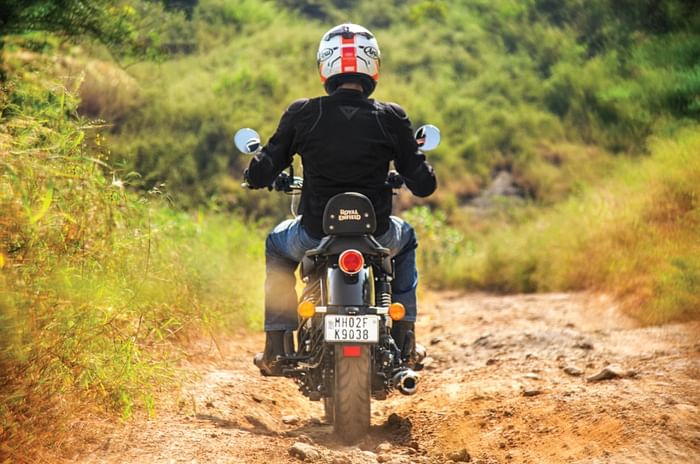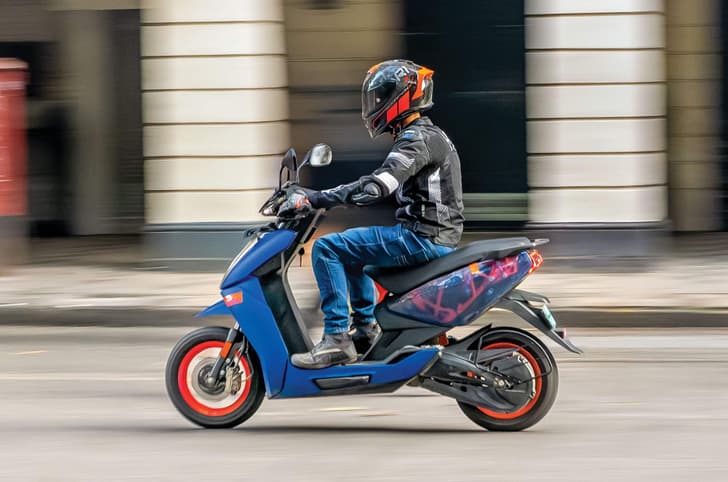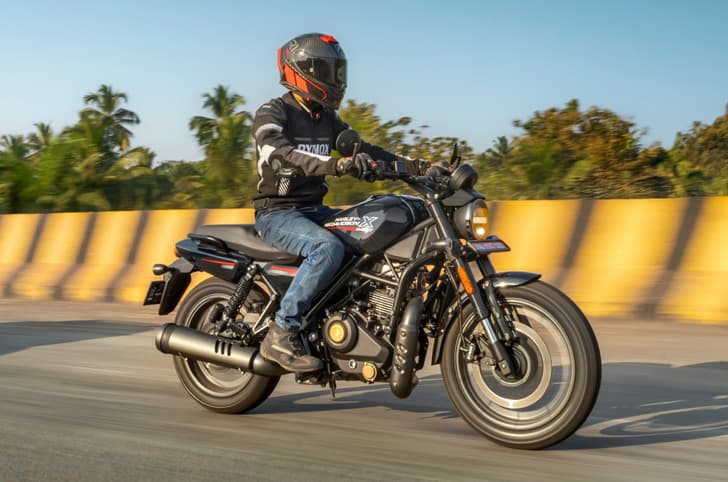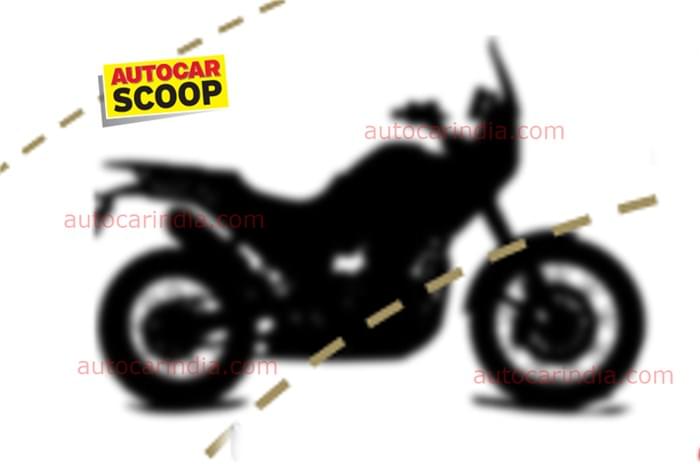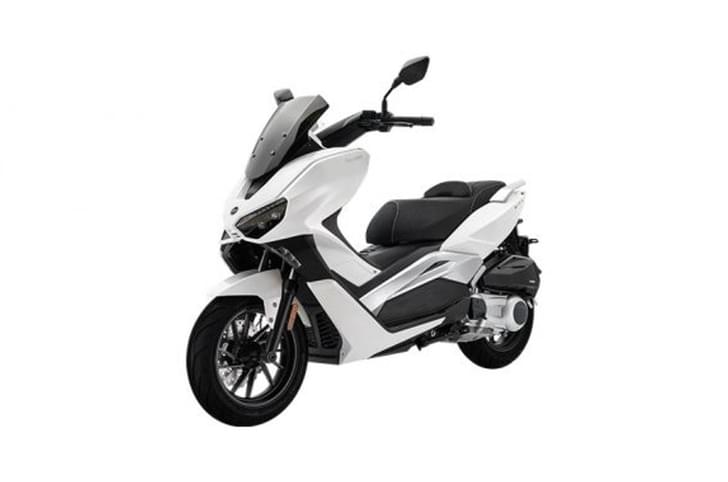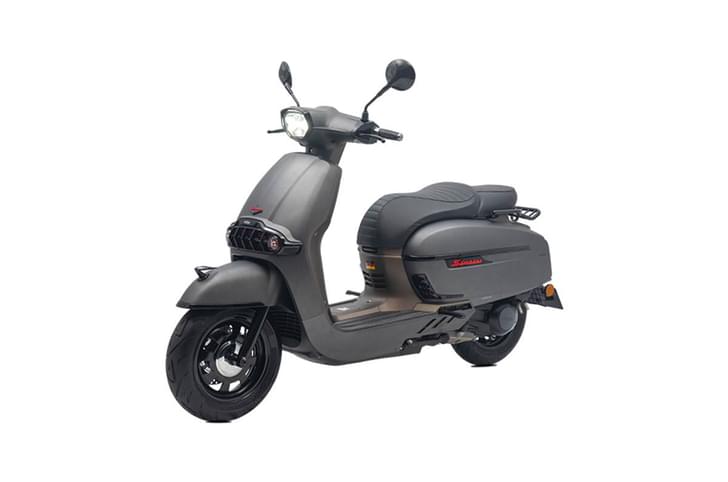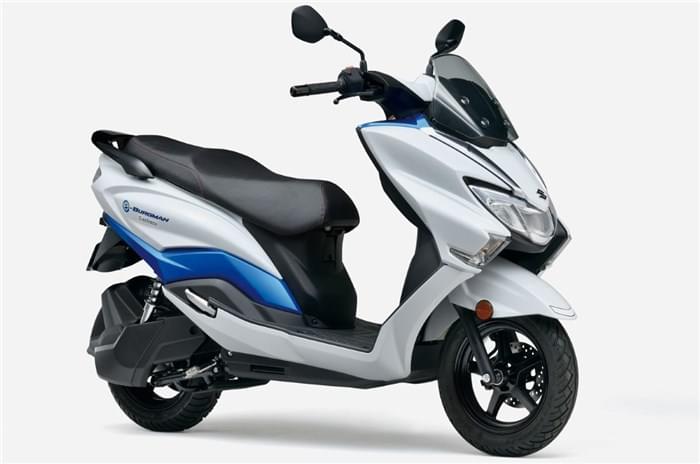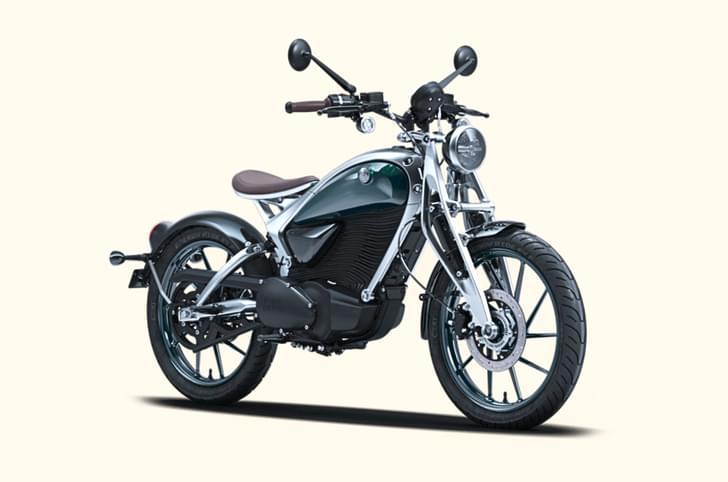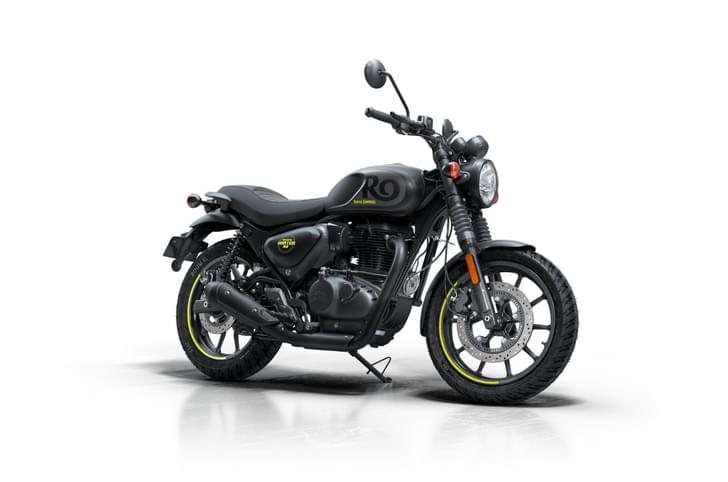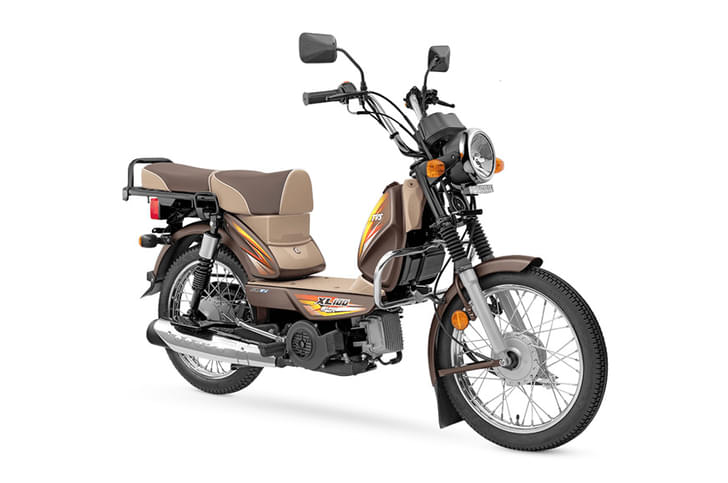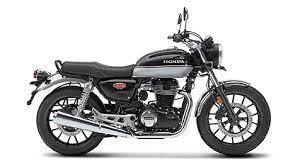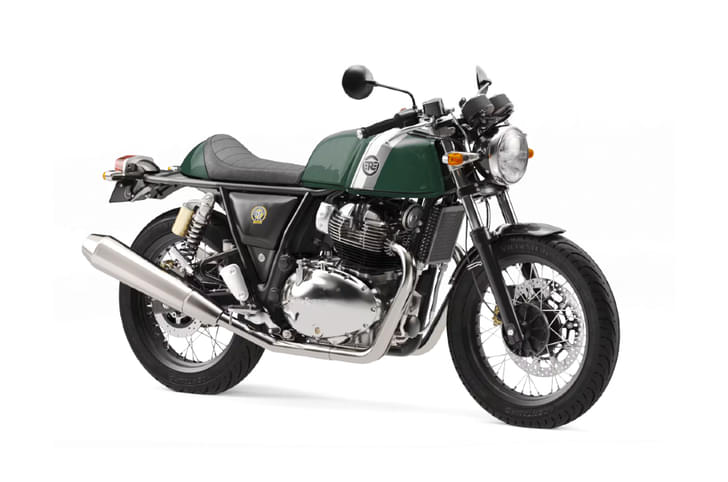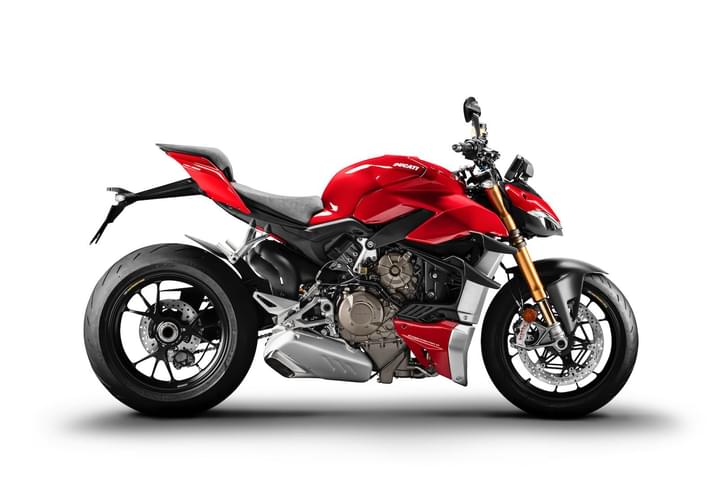Can you imagine the sleepless nights at Royal Enfield over the development of this new motorcycle platform? After all, this is the first time the company has revamped the very same 350cc platform that created its meteoric (sorry, not sorry!) rise in sales over the past decade.
Sleep or no sleep, it’s finally here now, and the new Meteor 350 serves as a replacement to the Thunderbird and Thunderbird X lines of motorcycles. Despite the Thunderbird being a strong brand in India, Royal Enfield has resurrected this charming name from its past, because the Thunderbird name couldn’t be used in certain international markets. While the company isn’t saying this yet, we believe this new platform will eventually underpin all of its 350cc models, including the Classic and other future variants.
And with that, let’s start with the least new aspect of what is quite literally an all-new motorcycle – the way it looks.
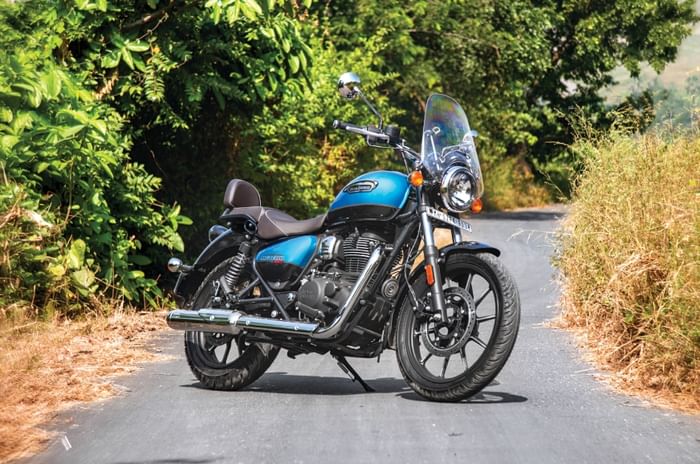
Royal Enfield Meteor 350: Design and details
From the images, things look quite similar to the now-defunct Thunderbird X (henceforth, referred to as TBX), even though everything has actually changed. Royal Enfield wanted to keep the design familiar and identifiable and that’s exactly what this bike is. However, when you really examine it, you’ll see that the Meteor no longer has that curved silhouette at the fuel tank, and while Thunderbird loyalists may miss it, I’m happy it’s gone.
In its place is a wide and impactful looking fuel tank whose shape reminds you of the ones you’d see on bikes like the Harley-Davidson Fat Boy. It looks and feels large between the knees, but this one holds 15 litres, against the 20-litre unit in the TBX. The side quarter panels have been simplified with just one triangular unit, while the seat is now split into two units. Meanwhile, the rear mudguard is larger, which helps reduce the visible air gap between it and the wheel.

The bike we have here is the top-of-the-line Supernova variant (there are three in total), with its dual-tone paint, large windscreen, tan seats and pillion backrest. But don’t worry, there are plenty more options if you don’t like this look and we’ll get to that later on. While I think the Meteor has nicer proportions than the TBX, the best elements are only visible upon a closer look.
Royal Enfield has paid considerable attention to the finer details. The new rotary switchgear looks quite cool, and feels nice and clicky to use. The chrome mirrors are great and I love how the front brake lever merges with the rounded master cylinder. Another nice touch is how the hinge for the chrome fuel cap is hidden and can only be seen when the flap is lifted. Over at the rear, the single round brake lamp gets a neat LED light surround, while the bulb-illuminated indicators run old-school circular optic lines. The quality of the backrest and windscreen, which are both available as accessories on the lower variants is also very good.
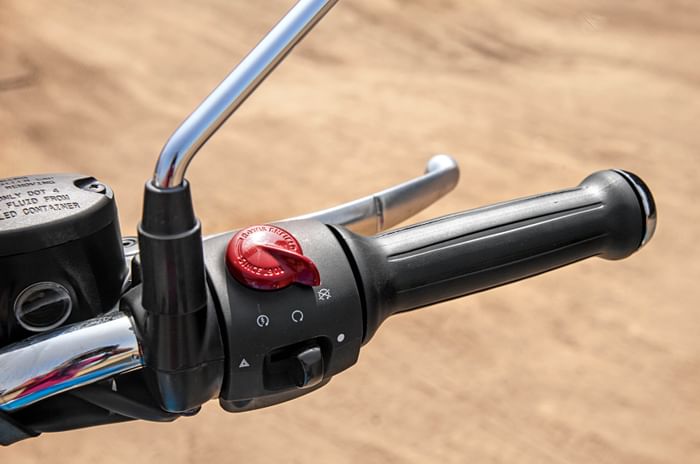
As for the headlamp, I have no complaints that it runs a 60/55 halogen bulb, because most LED lights on affordable motorcycles are quite underwhelming. The Meteor gets a small LED ring around the headlamp, but this is rather dull and can barely be seen in direct sunlight.
There is a good helping of chrome all around, but the engine cases are black. That’s a practical choice, because we found that the chrome cases on the 650s oxidise quite quickly in the coastline air of Mumbai and required frequent elbow grease to look their best. Quality-wise, nothing stood out poorly, except for some very faint streaks visible on the bright blue fuel tank in direct sunlight, and this is something Royal Enfield should be able to sort out once bikes start reaching customers. Overall, the Meteor has a simple, yet pleasingly premium feel to it and this is amplified by its smart-looking new instrument console.
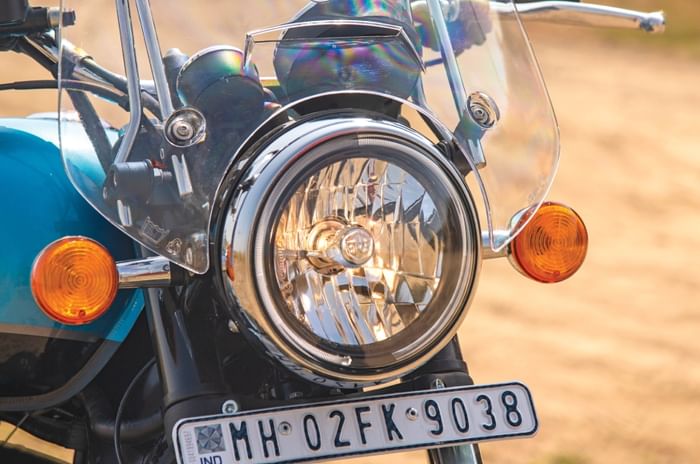
With an analogue speedo on the outer circumference and a digital display below, the unit tells you important things like how much fuel is left, what time it is and what gear you’re in, and it has two trip meters. That’s what you see on the large dial on the left, but the small dial on the right is a colour display for Royal Enfield’s new Tripper navigation system. Using Google Maps data, this system works when connected to the Royal Enfield app, and we found it to be quite intuitive and helpful. On the downside, it doesn’t give you any telephony related notifications because Royal Enfield says it wants this to be a distraction-free experience. If you decide not to use the Tripper Navigation, this display will simply show you the time.
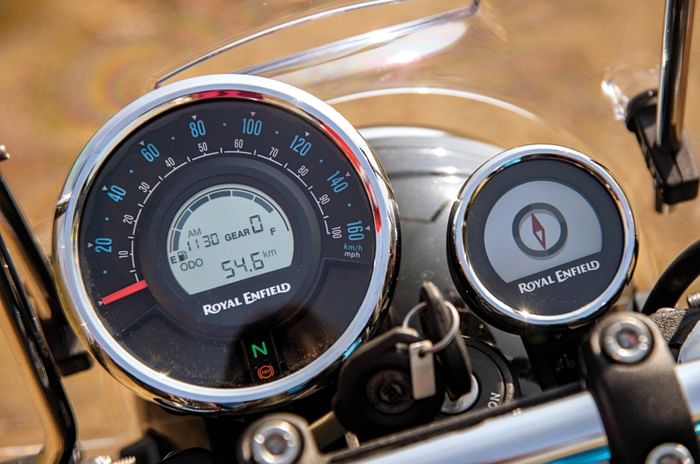
Royal Enfield Meteor 350: Engine and performance
Let’s begin by addressing the big concern – yes, this brand-new motor still feels like it belongs in a Royal Enfield. Although it’s fair to be concerned because the changes from the old UCE motor are drastic. The old pushrod-valve system is replaced by a SOHC two-valve head and while the engine remains air-cooled, there is an additional internal oil circuit within the cylinder head to aid cooling. Royal Enfield has also increased the bore by 2mm and reduced the stroke by 4.2mm, while also adding in a primary balancer shaft. The aim was not to chase after performance numbers but to increase the usable range of torque, while simultaneously stamping out the off-putting high-RPM vibrations.
The immediate impressions are very good. Start it up and there’s a clear thump to be heard, and you can also feel the big piston make its lazy oscillation through the foot pegs. In fact, this motor is never free of sensation in the handlebar and foot pegs, but at no point do the vibrations get harsh either – even when revving the engine to the limiter. Overall, there’s plenty of engine ‘feel’, but it never approaches the zone of crudeness, and I think RE has done well to achieve this balance.

The new 5-speed gearbox is smooth and slick, and it also has shorter throws than the old one, which is nice. The clutch is slightly on the heavy side in traffic, but it has good feedback and is easy to modulate – a slip-and-assist system would have been nice here. As for heat, there wasn’t much to be felt in the city, but the engine casing on the right side sticks out quite a bit. If you’re one of those slipper-wearing superstars, you better keep some burn cream handy for your right ankle.
What about performance? At 20.2hp and 27Nm, the specs are not impressive for a brand-new motor. Compare it with the BS6 UCE engine in the Classic 350 and power is up by just 0.4hp (and it’s produced 850rpm higher), while torque actually goes down by 1Nm. And yet, this engine manages to be 7.2sec quicker from 0-100kph than the BS6 Classic 350. So how has RE done this? Again, the answer lies not in the size of the numbers, but how usable they are.
On the Classic 350, 60kph was the sweet spot and 80kph was the maximum speed you could hold without the vibrations getting obnoxiously intrusive. With the Meteor, 80kph is a calm and enjoyable cruise and 100kph actually has even fewer vibes to be felt. But at this point, the engine is revving quite high, and while you can sustain this pace, it doesn’t feel as relaxing. For those of you wondering, 0-100kph took 17.8sec and the top speed was an indicated 120kph. Both those figures are lower than its rivals from Benelli and Jawa, but a typical RE customer will tell you that flat-out performance is of no consequence to them.
As for fuel efficiency, it returned 34.7kpl in the city and 37.1kpl on the highway. These figures are almost on par with the BS6 Classic 350.
Royal Enfield Meteor 350: Chassis and dynamics
The other big change comes in the double-downtube frame that replaces the aged single-cradle unit. The seat height is now down by 10mm to a welcoming 765mm, while the ground clearance has climbed to a fairly substantial 170mm. Now 26 degrees, Royal Enfield has sharpened the steering angle by one degree, but the wheelbase has increased by 50mm over the TBX. Dimensionally, it’s also slightly longer and wider than the TBX. Ground clearance is now up to 170mm, so it’s now even more Ladakh-ready.
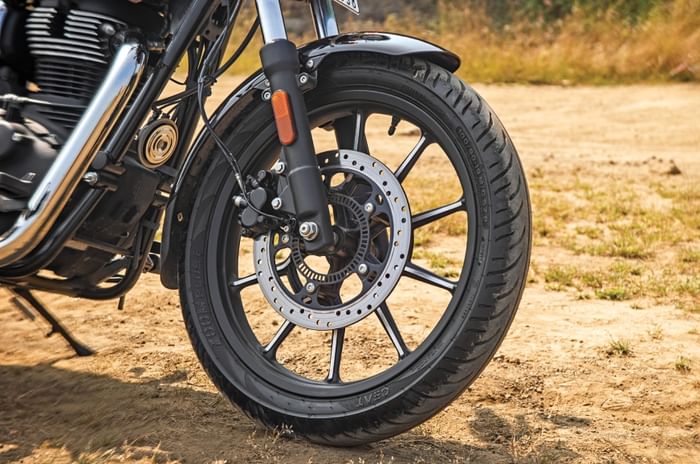
What I was most keen to see was how much weight has been lost, and with a kerb weight of 191kg, the answer is 6kg. That’s not a lot, especially when you recall that the fuel capacity has reduced by five litres. RE tells us that weight wasn’t an issue for its customers and that this bike manages its weight better. I’ll agree with the second part, and the Meteor feels very well balanced and easy to manage at low city speeds. With that said, this is still a large and heavy machine and not something we’d recommend as a first motorcycle in the Indian riding environment.
The Meteor continues to run a 19-inch front wheel, while the rear has reduced from 18 to and a 17-inches. There are wider tyres at both ends and the bike will be supplied with either MRF or Ceat tyres - our bike had the latter and grip seemed perfectly fine for this application. The brakes are bigger at both ends too, with a 300mm front disc and a 270mm rotor at the rear. Braking erformance is good when you really haul on the anchors, but the front brake feel is dull, as with many cruisers.
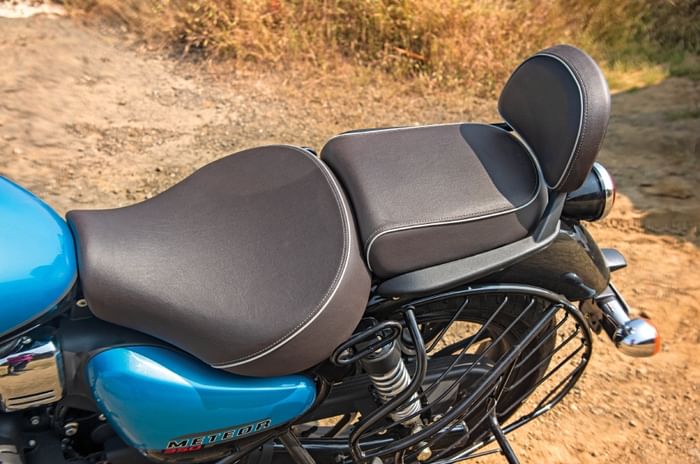
Ah yes, let’s not forget, this bike is a cruiser. Your feet are rather forward-set (but not as much as on a Harley) and while I’m no fan of the load this riding position puts on the back, I’ll admit it was elatively quite comfortable. The big windscreen on our bike was easy to see through and caused almost no helmet buffeting, while the spacious and supportive seat was one of the best I’ve experienced on an Indian motorcycle. The bike is spacious enough to carry two 6ft-tall individuals in comfort. The rear seat is quite nice as well, although the pillion foot pegs are slightly rear-set and the padded backrest does eat into the room a little bit.
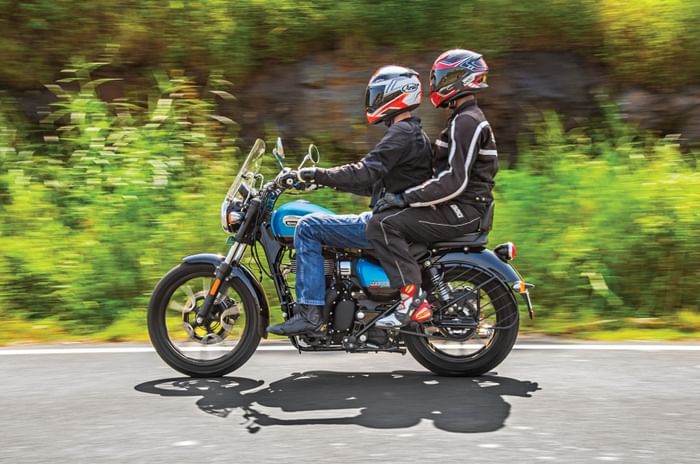
It may not be much lighter than the TBX, but the Meteor is certainly more confident on its feet. 350cc Royal Enfields have always been rather archaic-feeling handlers, with plenty of flex and not much finesse. The Meteor’s frame is much stiffer and the new suspension setup does a much better job as well. It’s not soft and squishy, but it balances comfort and control much better. Potholes are dealt with well and only very sharp hits at the front end would cause the fork to bottom out.
The handling character is now far more confident, stable and predictable. While it’s still far from sporty, it no longer causes you to take a deep breath and dial up the concentration every time the road snakes away from the dead-ahead. You can carry some nice sweeping speed through the bends, but get carried away and the footpeg feelers will loudly scrape you back into behaving yourself.
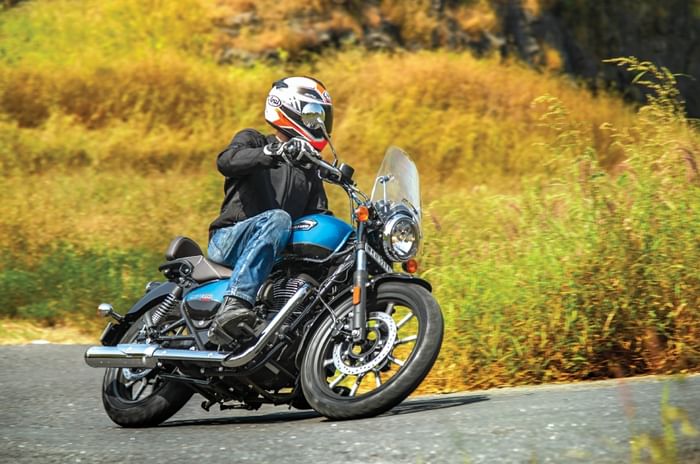
Royal Enfield Meteor 350: Customisation options
Clearly, the engine and chassis represent massive improvements, but RE isn’t stopping there. The company knows that individuality and standing out of the crowd is a big deal for their customers, and that’s where the Make It Yours programme comes into play.
Essentially, you can choose from a huge list of accessories, including eight different road-legal exhausts, eight engine-guard designs, six seats, multiple seat covers, two different windscreens and many colour options. RE says there are up to five lakh custom configurations possible, which is easily the highest any Indian bike has ever offered. But the incredible thing is that you can design your very own creation using the RE app, and once you’ve paid for the bike, the company says your motorcycle will be put together in the factory in no more than 48 hours. I’m not sure if any other large-scale automobile manufacturer has ever been able to offer this level of customisation at such speed.
Royal Enfield Meteor 350: Conclusion
With this motorcycle, Royal Enfield hasn’t thrown out the rule book, and the Meteor doesn’t pull any shock surprises. It still looks, feels and rides as you’d expect from a Royal Enfield, but it does so with the finesse and sophistication that was sorely lacking all these years. Buying into the charm no longer includes dragging a sack full of compromises, and the Meteor is good enough to consider even if you’ve never owned a Royal Enfield before. It’s also good enough if you want to upgrade from a current 350.
Prices start at Rs 1.76 lakh for the Fireball variant, while going up to Rs 1.81 lakh for the Stellar and Rs 1.90 lakh for the Supernova (ex-showroom, Chennai). That's a few thousands more than the base model of the BS6 Classic 350 and a whole Rs 10,000 less than the surprise rival from Japan. The Meteor is priced about on par with the dual-channel ABS Jawas, while being a fair amount cheaper than our previous pick of the sub-500cc retro segment, the Benelli Imperiale 400.
Overall, Royal Enfield has produced an authentic feeling, yet well-rounded and impressive product. While the pricing isn't sensational, it's definitely competitive and I think it's safe to say they've earned an end to all those sleepless nights!
